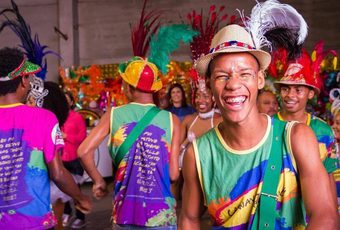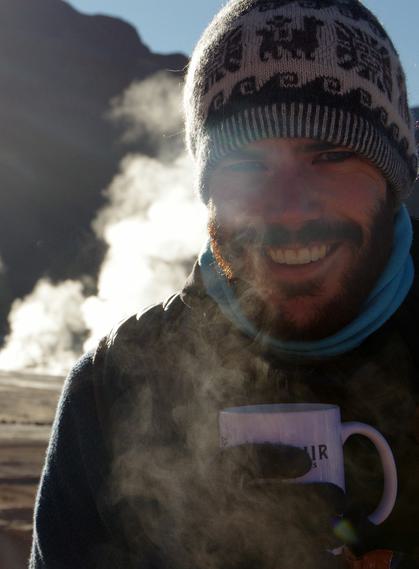Blog
The best way to visit Otavalo Market
Each Saturday morning, the small Andean village of Otavalo is home to one of Latin America's most important indigenous markets. It sounds impressive. It is impressive - if you go to the right bit that is. The trouble is that most visitors don't. Through little or no fault of their own, they don't realise that there are others markets away from the colourful bags and machine-produced alpaca wool hats of the tourist market. Most think that they are in Otavalo Market, the proper bit. There's a very good reason for this.
Actually, it's not a very good reason, but an explanation at least.
The tourist trap
In a typical tour operator-consumer relationship, there's someone else sharing the bed, so to speak. A middle man, an agency who deliver the holiday and look after you on your travels. A small handful of them are very good, the majority are adequate at best.
The issue we took with such an arrangement, and why we effectively kicked them out of bed, is that your holidays would have to go through a non-Pura filter. What you and what we care about, has to align with what they care about. And what they care about has to exist within their list of excursions and accommodation. These are usually created for wider consumption, compromised to suit the demands of the masses. So we go direct, working with local partners, not suppliers. Everyone wins - the locals, the destination, us and you, the visitor.
So if we care about why Otavalo is such an important market, as opposed to just exploiting the mere fact that it is, then we can share it with you in the way that we experienced it. Unfiltered.
I suspect you won't find too many other tour operators talking about the other (non-tourist) side to Otavalo. They talk about shopping and bartering, foregrounding the vibrancy and colour, the chance to stare at locals. Some of them run day trips from Quito, which belong in the same bracket as those day trips to Mindo.

It's important to know that when you are sold an excursion to Otavalo, there's a good chance this is basically what you'll get. Which is fine, on a superficial level. You'll leave with some nice photos, laden down with souvenirs. But you'll have also missed a golden opportunity to understand a little something about life in the highlands. You'll miss the chance to see something that could challenge you in ways you didn't expect and create more vivid and deeper memories, based around interactions with local people. And there's still ample time to laden yourself down with gifts anyway.
The Pura Aventura way
So when we consider how to share Otavalo Market with you, we approach it with a degree of caution and consideration. Anyone can take you shopping after all, without having gone to the effort of actually visiting the place themselves. We can't do that and say things like "we make travel personal" with any degree of credibility. We can't create thoughtful holidays if we don't form our own opinions, and share them.
Let's get to the heart of it then, literally and figuratively. The indigenous bit, where locals from surrounding farming communities gather once a week to sell their livestock and buy goods from others. They don't do it for the benefit of you or I, but rather to feed themselves and earn a living. The market has the feel of an important event; people group together to chat, kids pose for photos with tiny puppies, pigs are shuttled out of trucks at great effort. The Pan-American Highway gets overrun with locals going this way and that. Suddenly we are part of something much bigger than us. There are few tourists around.

Market life
Now for the bit that we don't Photoshop out. The Otavalo Market is loud and vivid. It's a bit in your face. Pigs squeal noisily, chickens are cooped in cages until they are taken out and carried around the market by their new owners by their feet. Sheep and cows are tethered up, waiting to be inspected by prospective buyers. Vegetarians might find it clashes with their sensibilities. Even the most dedicated carnivores might find it confronting. There were moments when I felt a little uncomfortable. I can only imagine what my non-meat eating wife would have made of it all. But stay with me.
There is a conversation to be had around the institution of the local market. The starting point is a very broad statement that this, put simply, is the backbone of life in the Ecuadorian highlands. It is unfiltered and not, in any way, a show put on for tourists. For me, this is essentially what we seek when we travel. You will have your own perspective on this matter, but I think the basic question is: where do we draw the line?

I spoke with Luis, a local farmer who arrived at 5:30am. He had one cow with him, five others back home. He is hoping to fetch between $60-70 for this one - a substantial sum of money which will help him buy essential food staples for his family. With the crowds thinning as we spoke, it's unlikely he had any success that day, though he'll try his luck again next week. It's a competitive arena, with no guarantees. His human story makes it a little harder to be judgemental. I wished him luck, thanked him for his time and headed off between the stalls of fruit and vegetable stands. Stocked up high were piles of corn, bananas, pineapples, papaya, peppers, guame, coconuts, cacao, guanabana and more.
So back to that line we were about to draw. To take it to its extreme, I certainly don't, need to see Luis greet his wife and take a shower in the morning. I don't really need to know how many cups of coffees he has a day. But then if we go to the other extreme, I feel equally uncomfortable taking my photos of volcanoes, crater lakes and brightly coloured bags away from the highlands and telling it to keep everything else to itself. We are sheltered from this in the more developed parts of the West. It wasn't always the case, but now we largely buy meat in neat packages from a supermarket, the end result of a process which begins out of sight in the countryside.
You don't get people like Luis kicking around in the chill aisles of Waitrose.

How to visit Otavalo Market with Pura Aventura
Well, first you obviously have to go to Ecuador, which we can help with. More specifically, to one of our favourite lodges up a cobbled street of the Pan-American, away from the bustle of the town.
From here we walk out of the lodge and through rolling farmland, passing terraced hills and rows of eucalyptus trees, their leaves almost blue in the early morning light. Horses and cattle interrupt your passing-by with interest and no small amount of surprise. Cockerels crow their morning greetings, the odd dog barks, mist hangs in the air and fallen melons gather on the ground. Everything is calm. The grass is green, fields are wide and the air is fresh. This is how the animals sold at Otavalo live throughout the highlands, on small scale farms such as these. Organic is not an optional upgrade.
The Pothole is Pura Aventura's popular monthly email. We share what we love, what interests us and what we find challenging. And we don't Photoshop out the bits everyone else does. We like to think our considered opinions provide food for thought, and will sometimes put a smile on your face. They've even been known to make people cry. You can click here to subscribe and, naturally, unsubscribe at any time.
The Pothole is Pura Aventura's popular monthly email. We share what we love, what interests us and what we find challenging. And we don't Photoshop out the bits everyone else does. We like to think our considered opinions provide food for thought, and will sometimes put a smile on your face. They've even been known to make people cry. You can click here to subscribe and, naturally, unsubscribe at any time.








 By
By 

